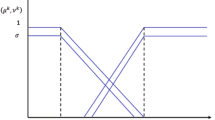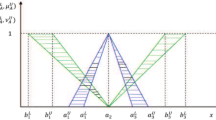Abstract
Nowadays the traffic congestion is being a common problem in major cities, every time the travel time is increasing and also the number of private cars. It is urgent to take actions to solve this problem. The urban transport is becoming into the best way to fight against congestion; but to make it more attractive to users it has to be more efficient (less travel time, less waiting time, low fare). The urban transport process has four main activities: Network design, Timetabling, Vehicle scheduling and Crew scheduling. The problem presented here is about the integration of the frequency and departure time scheduled both are subactivities of the timetable construction, besides it includes multiple periods planning and multiperiod synchronization, also the authors consider uncertainty in demand and travel time using fuzzy numbers. The planners faced this problem everyday. The authors created a mathematical model including the characteristics previously mentioned, the objectives of this model are to minimize the total operation cost, to maximize the number of multiperiod synchronization between routes, and to minimize the total waiting time for passengers. The SAugmecon method is used to solve the problem, 32 instances were randomly generated based on real data, and the comparison of two defuzzification methods (k-preference and second index of Yager) is presented. Also, the comparison of the problem with uncertainty on demand and uncertainty on demand and travel time is presented.









Similar content being viewed by others
References
Baskaran R, Krishnaiah K (2012) Simulation model to determine frequency of a single bus route with single and multiple headways. Int J Bus Perf Supply Chain Model 4(1):40–59
Brito J, Martinez FJ, Moreno JA, Verdegay JL (2012) Fuzzy optimization for distribution of frozen food with imprecise times. Fuzzy Optim Decis Mak 11(3):337–349
Campos L, Verdegay J (1989) Linear programming problems and ranking of fuzzy numbers. Fuzzy Sets Syst 32(1):1–11
Ceder A (2007) Public transit planning and operation: theory, modelling and practice, 1st edn. Elsevier, USA
Chakroborty P (2003) Genetic algorithms for optimal urban transit network design. Comput Aided Civ Infrastruct Eng 18(3):184–200. doi:10.1111/1467-8667.00309
Chen H (2002) Stochastic optimization in computing multiple headways for a single bus line. In: Proceedings of the 35th annual simulation symposium, pp 316–323
Eranki A (2004) A model to create bus timetables to attain maximum synchronization considering waiting times at transfer stops. PhD Thesis, University of South Florida
Hadas Y, Shnaiderman M (2012) Public-transit frequency setting using minimum-cost approach with stochastic demand and travel time. Transp Res Part B Methodol 46(8):1068–1084
Ibarra-Rojas OJ, Rios-Solis YA (2012) Synchronization of bus timetabling. Transp Res Part B Methodol 46(5):599–614
Liu L, Yang J, Mu H, Li X, Wu F (2014) Exact algorithms for multi-criteria multi-modal shortest path with transfer delaying and arriving time-window in urban transit network. Appl Math Model 38(9–10):2613–2629. http://www.sciencedirect.com/science/article/pii/S0307904X13007269
Kumar M, Sarkar P, Madhu E (2013) Development of fuzzy logic based mode choice model considering various public transport policy options. Int J Traffic Transp Eng 3(4):408–425
Mavrotas G (2009) Effective implementation of the e-constraint method in multi-objective mathematical programming problems. Appl Math Comput 213:455–465. http://www.sciencedirect.com/science/article/pii/S0096300309002574
Qi J, Yang L, Gao Y, Li S (2015) Robust train timetabling problem with optimized train stop plan. In: Fuzzy systems and knowledge discovery (FSKD), 2015 12th international conference on, pp 936–940
Sarkar A, Sahoo G, Sahoo U (2012) Applications of fuzzy logic in transport planning. Int J Soft Compt 3(2):1–21
Shangyao Y, Chi C, Tang C (2006) Inter-city bus rounting and timetable setting under stochastic demands. Transp Res Part A 40(1):572–586
Sumalee A, Uchida K, Lam W (2011) Stochastic multi-modal transport network under demand uncertainties and adverse weather condition. Transp Res Part C Emerg Technol 19(2):338–350
Szeto W, Yongzhong W (2011) A simultaneous bus route design and frequency setting problem for tin shui wai, hong kong. Eur J Oper Res:141–155
Teodorovic D, Lucic P (2005) Schedule synchronization in public transit using the fuzzy ant system. Transp Plan Technol 28(1):47–76
Tirachini A, Hensher D, Rose J (2014) Multimodal pricing and optimal design of urban public transport: the interplay between traffic congestion and bus crowding. Transp Res Part B Methodol 61(1):33–54
Wang L, Qin Y, Xu J, Jia L (2012) A fuzzy optimization model for high-speed railway timetable rescheduling. Discr Dyn Nat Soc:1–22
Wu J, Liu M, Sun H, Li T, Gao Z, Wang D (2015a) Equity-based timetable synchronization optimization in urban subway network. Transp Res Part C Emerg Technol 51:1–18
Wu Y, Tang J, Yu Y, Pan Z (2015b) A stochastic optimization model for transit network timetable design to mitigate the randomness of traveling time by adding slack time. Transp Res Part C Emerg Technol 52:15–31
Yager R (1981) A procedure for ordering fuzzy subsets of the unit interval interval. Inform Sci:143–161
Yang L, Li K, Gao Z (2009) Train timetable problem on a single-line railway with fuzzy passenger demand. Fuzzy Syst IEEE Trans 17(3):617–629
Yao B, Hu P, Lu X, Gao J, Zhang M (2014) Transit network design based on travel time reliability. Transp Res Part C Emerg Technol 43(3):233–248
Zhang J, Arentze T, Timmermans H (2012) A multimodal transport network model for advanced traveler information. J Ubiq Syst Pervasive Netw 4(1):21–27
Zhang W, Reimann M (2014) A simple augmented e-constraint method for multi-objective mathematical integer programming problems. Eur J Oper Res 234:15–24. http://www.sciencedirect.com/science/article/pii/S0377221713007376
Zhao F, Xiaogang Z (2008) Optimization of transit route network, vehicle headways and timetables for large-scale transit networks. Eur J Oper Res:841–855
Acknowledgements
COMPSE 2016, UANL, FIME, Project 280081 of CONACyT Collaboration Networks 2017, Do Analytics, UMA.
Author information
Authors and Affiliations
Corresponding author
Rights and permissions
About this article
Cite this article
Avila-Torres, P., Caballero, R., Litvinchev, I. et al. The urban transport planning with uncertainty in demand and travel time: a comparison of two defuzzification methods. J Ambient Intell Human Comput 9, 843–856 (2018). https://doi.org/10.1007/s12652-017-0545-x
Received:
Accepted:
Published:
Issue Date:
DOI: https://doi.org/10.1007/s12652-017-0545-x




